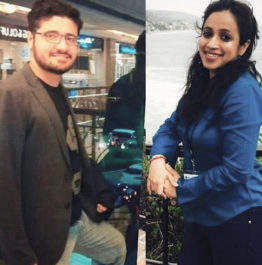FaceCrop: The latest success story for Amazon Catalyst/UW partnership
University of Washington student Jumana Karwa and colleague Saurav Tomar have began development of a video compression program called FaceCrop, thanks to a little-known grant program called Amazon Catalyst and its partnership with the university.
FaceCrop allows for otherwise lengthy high-definition videos, specifically lecture and educational videos, to become more data efficient. The team’s inspiration came from the lack of access to high-speed internet in developing countries, where millions of people would otherwise benefit from better data connection. The team ultimately sees the tool spreading to many underdeveloped markets.
Karwa is a graduate student at UW Tacoma working in computer science and engineering systems, and Tomar is a long-time friend based out of India, with whom she collaborates on development of the project. Karwa’s studies focus on geographic information systems and machine learning, and she intends to continue working on FaceCrop after graduation in March 2017.
Karwa and Tomar had participated in hackathons together before FaceCrop, and Tomar has proven to be an invaluable asset and was characterized by Karwa as very bright and innovative with technology. Bumping into each other at hackathons spurred their discussions about their shared experiences in computer technologies, which eventually led to the video compression idea.
Karwa’s goal with FaceCrop is to change the way videos are compressed on the internet by taking the informative parts and trimming away the rest, as well as making the file size significantly smaller. This would allow videos to be easily streamed over 2G internet speeds and be saved onto online storage.
Karwa won first place at the Facebook Seattle’s Students of Color Hackathon with said prototype in 2015. The prototype, which focused on decreasing the file size of YouTube videos, only took 17 hours to complete. After winning first place the team was awarded with a trip to the global Facebook hackathon, where they were finalists.
“I just realized we had this project with a winning idea for Facebook, so perhaps we could apply for kicks,” Karwa said. They applied to the Catalyst fellowship via a relatively simple 20-question survey, and found out they would move on to the committee pitch on the Seattle campus just four weeks later.
After winning the fellowship, FaceCrop used the bulk of their funding to hire a couple of interns in order to shorten the project’s timeline. Further down the line they will be building a distribution platform around the program, additionally integrating the technology into Facebook Messenger to allow for sharing “FaceCropped” videos via messages.
FaceCrop, which received its funding in February 2016, is just one of 17 winners of funding ranging from $10,000 to $100,000 by the Catalyst program in the last year. The applications are on a quarterly basis and the budding fellowship program is just getting started.
“The FaceCrop team is definitely one of the best ones,” said Lizzie Tao, marketing manager of Amazon Catalyst. “To receive any funding is a testament to the project’s skill and caliber.”
Amazon Catalyst’s funding is not just limited to business plans or computer program pitches.
“It’s not just for startups — we fund ideas,” Tao said. “A startup presupposes that you have a business plan and it’s really well thought out and maybe you’re incorporated, but in fact we can fund as much and as little as a well thought out idea.”
In the program’s announcement press release, Amazon stated that to be awarded funding, projects must address a key problem facing the world today. The announcement also stated the program is open to a wide swath of people involved with the university, from undergraduate students to librarians and nurses.
“The one thing is that we’re looking for projects that have a greater impact in solving a problem,” Tao said.
The projects and ideas should be wide-reaching and scalable, and FaceCrop is just one example of a pitch that fit the criteria well enough to land the fellowship.
Other Amazon Catalyst grant winners include an early warning system for earthquakes in the Pacific Northwest that uses GPS and seismic data; a design for a solar-powered, high-altitude drone that enables scientists to access data about some of the world’s hardest-to- reach places, and KUOW’s “Ask a __” segment, wherein participants come together to have conversations with people of different backgrounds.
Amazon Catalyst is currently only partnered with the University of Washington, citing a large diversity of departments and the shared location of the Seattle region, but expansion to other universities is an eventual goal. Catalyst was announced on Nov. 5, 2015 and soon after accelerated into a highly competitive grant program, attracting over 227 applicants in fall quarter 2016 alone.
With expansion into other universities around the world, Amazon Catalyst hopes to be able to fund spearheads of change in the world, with practical and novel solutions to real world problems. The program hopes to see success at other universities like it has at the UW. By expanding, more students will have the opportunity to bring ideas to fruition. After all, if it were not for Amazon Catalyst, FaceCrop may have just stayed a prototype.
Read your stories
The Daily of University of Washington -

Face Crop
by Zackary Bonser
